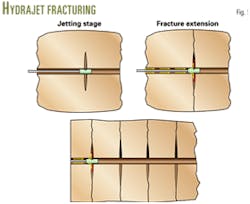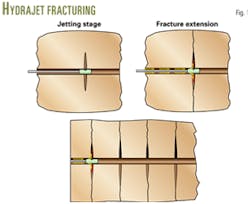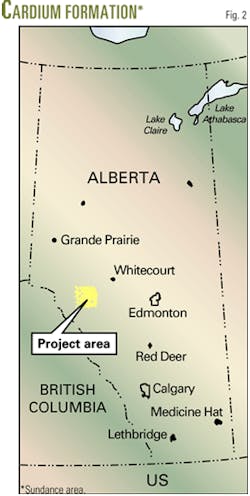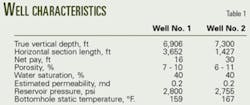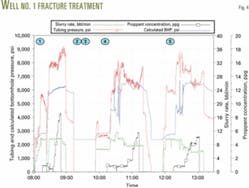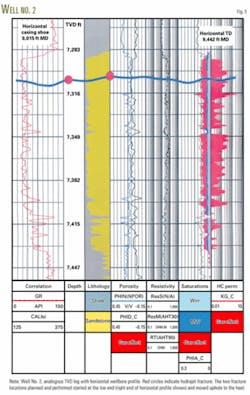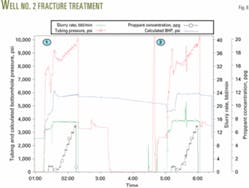Hydrajet fracturing, which can place multiple propped hydraulic fractures in precise locations, effectively stimulated two underperforming horizontal openhole gas wells in the low-permeability Cardium formation in west-central Alberta.
Prior to this technology, the industry had few economic methods for controlling fracture placement in openhole, or uncemented cased-hole horizontal wellbores.
Hydrajet fracturing combines hydrajetting with hydraulic fracturing.1 Unlike other methods, this process avoids expensive and risky mechanical isolation or sealing techniques. It involves running a specialized jetting tool on conventional or coiled tubing. Then to initiate the hydraulic fracture, dynamic fluid energy jets form tunnels in the reservoir rock at precise locations (Fig. 1).2 The hydraulic fracture is then extended from that point outward.
By repeating the process, one can create multiple hydraulic fractures along the horizontal wellbore.
Low-permeability formations
Many horizontal wells in low-permeability, heterogeneous formations require stimulation treatments for optimizing production. As in vertical wells, near-wellbore damage also remains a concern in horizontal wellbores.
Low-permeability formations typically have vertical heterogeneities that limit or prevent flow to a horizontal wellbore. These heterogeneities may result from porosity and permeability variations or small laminations of nonpermeable minerals.
Only one thin nonpermeable lamination, too thin to be detected by conventional logging tools, can block vertical flow to the horizontal wellbore.
Many low-permeability reservoirs with openhole laterals have high skin damage compared to reservoirs with moderate or high permeability. Treatments for removing this damage often have proven ineffective in low-permeability sandstone formations, especially in those with long openhole laterals.
Hydraulic fracturing is a proven effective treatment for optimizing production rates in many types of vertical well, but these treatments seldom succeed in openhole horizontals.1-4
Many simultaneous fractures created means that each fracture will have less width and length. Also fractures that are not well distributed along the lateral but are in a cluster may improve production for only a limited time.
Bullheading techniques tend to produce only multiple fractures with limited length and conductivity. These jobs often place most of the treatment fluid near the heel of the openhole section.
Cardium formation
The Late Cretaceous Cardium formation in the Sundance area of Alberta is near the Rocky Mountains foothills (Fig. 2) and is typically gas-saturated, with some condensate and minor amounts of connate water.5 It generally consists of laminated to lenticular succession of low and very low porosity and permeability sandstones. Well logs generally cannot distinguish these porosity and permeability variations.
In this area, the formation is at about a 7,546-ft depth and overlays the Blackstone shale and underlies the Muskiki shale.
As seen from above, the Cardium hydrocarbon reservoir lies in a southeast to northwest direction.
The reservoir has fine-grained sandstone with less than 15% (typically less than 9%) porosity and less than 10 md (typically less than 1 md) matrix permeability.
The reservoir does not have bottomwater, and formation water generally is bound in the smaller pore throats of the finer grained sediments.
Gas production comes mostly from the courser sands that have less than 40% water saturations. Wells typically produce sweet gas with about 20 bbl/MMscf of condensate and less than 10 bbl/MMscf of water. The produced water is typically condensation from the produced gas.
Well completions in the Cardium attempt to contact natural fractures that act as gas conduits. In both vertical and horizontal wells, hydraulic fracturing tries to intersect these natural fractures.
Over the years, horizontal well drilling costs in the Cardium have become comparable to those in vertical wells with fracture stimulation. As a result, some operators drilled many horizontal wells to find and contact the natural fractures. This succeeded only in part because many wells contacted only low-permeability rock and other wells were damaged badly during drilling or completion.
Currently, the area has a large inventory of suspended, under producing, and uneconomic horizontal wells.
Canadian Natural Resources Ltd. (CNRL) hydrajet fractured two wells with horizontal openhole completions in the Cardium. Table 1 lists some features of the two wells. Both wells had laterals drilled from the southeast to the northwest, perpendicular to the expected hydraulic fracture direction.
Gamma ray, rate of penetration (ROP), and gas count logs were the only logs available for determining the location for placing the hydraulic fractures. The gas count log provided the primary information.
The treatments selected used gelled frac oil that had proven success in fracturing many vertical wells in the area.
The jobs used jointed tubing because of the unavailability of coiled tubing of adequate size and length. A snubbing unit ensured well safety while moving tubing uphole between fractures.
Well No. 1
Well No. 1, while being drilled underbalanced, flowed up to 2.0 MMscfd to the atmosphere. Formation damage occurred because operational issues required the well to be killed with water. This resulted in only a lazy pressure buildup with no gas flow from the well. The well essentially was dead.
CNRL selected five locations with high gas counts on the gas count log for hydrajet-fracturing (Fig. 3). One log from an offset vertical well 1 mile away was used as an analogous TVD log for this well.
Nearby vertical wells had a fracture gradient of 0.79 psi/ft; therefore, 0.88 psi/ft was selected as a possible worst case. Using this worst case, the analysis indicated that the expected tubing-casing annulus pressure at the surface was 3,770 psi or 87% of the rated casing yield pressure. This high pressure was acceptable because the well contained new 7 in., J-55 casing,
The operator selected an arbitrary 26,500-lb size for each of the five fractures because it considered this size sufficiently large for penetrating through the damage, contacting the full vertical porous height, and achieving a reasonable fracture length.
The job experienced treatment fracturing pressures of 0.97 psi/ft, causing the tubing-casing annulus pressures to rise to nearly the rated casing yield pressure (Fig. 4).
Also excessive fracturing and casing-tubing annulus pressures caused two of the five planned fractures to be aborted. The aborted locations were in low-porosity pay sections.
Post-fracturing pressure leakoffs were extremely slow because of the low formation permeability and the lack of the hydraulic fractures contacting, to any extend, the natural fractures.
The job required 6 days instead of the anticipated 2 days because operational issues caused delays and snubbing the tubing between zones was much slower than expected.
After treatment the well produced a steady 640 Mscfd at 360-psi bottomhole flowing pressure (BHFP) for 3 months. It is likely that larger fracture treatments would have yielded higher production rates, but given the formation heterogeneities it is not a certainty.
Well No. 2
Fig. 5 shows the profile of horizontal Well No. 2. For an analogous TVD log, the analysis used the poorer of two vertical producers, offset from Well No. 2 by about 0.5 miles.
The analysis expected a small shale break about 56 ft from the top of the zone, actually a fault, to form a barrier to gas production from the bottom of the zone and possibly a barrier to a hydraulic fracture.
Well No. 2, while being drilled underbalanced, flowed 100-175 Mscfd to the atmosphere. The operator considered abandoning the well, but instead left it as a suspended well with essentially no gas flow.
On this well, the hydrajet fracturing job involved much more prejob planning than in the first well in order to improve the efficiency of the operation.
The gas count log indicated several locations with higher gas counts, but to keep snubbing costs down, the job included only two fracturing locations to ensure a 1-day completion of the operation (Fig. 5).
Although the fracture gradient in nearby vertical wells was 0.79 psi/ft, this job used a 0.93 psi/ft gradient for the worst-case projection.
This would result in a 4,350-psi wellhead pressure or 87% of the rated casing yield pressure for the new 7 in., J-55 casing that was a heavier weight than in Well No. 1.
The rated casing burst pressure equaled a 1.02 psi/ft fracture gradient, which was not expected because the planned fractures were in clean sandstone.
The analysis indicated that a 66,000-lb treatment size for each zone would achieve good conductivity for up to a 164 ft length, which was more than sufficient to intersect a seismic-defined fault that flowed economic gas rates in a vertical offset even without hydraulic fracturing.
The 1-day job had treatment fracturing pressures as expected with a 0.79 psi/ft fracture gradient (Fig. 6) and costs were within the authorization for expenditure (AFE).
The slow post-fracturing pressure leakoffs indicated that the hydraulic fractures did not intersect any permeable natural fractures, although fracture simulation pressure matching indicated that the desired fault was intersected, but without any apparent benefit.
The well produced 200 Mscfd at a BHFP of 620 psi for the first week following the treatment. Slow load fluid recovery interfered with the gas production.
A coiled-tubing cleanout did not bring any proppant to surface, indicating that the fracturing jobs had placed all the proppant into the fractures. Modifications of the coiled-tubing bottomhole assembly were required to be made to allow the string to pass the first frac depth.
This indicated that the fracture was at the intended depth and that the hydrajet had created a hole or slot.
The second coiled tubing trip reached the toe without difficulties.
For gas production, Well 2 was a poor candidate for treatment and its permeability was considerably lower than estimated.
The well was considered geologically impaired because the fault that the frac treatments intersected was not a permeable gas conduit and there were no other permeable natural fractures intersected.
It is possible that very large fracture treatments may have resulted in more economic gas production, but again there is uncertainty because of formation heterogeneities.
Acknowledgments
The authors thank Halliburton and Canadian Natural Resources Ltd. for permission to publish this paper.
References
1.Love, T.G., et al., "Selectively Placing Many Fractures in Openhole Horizontal Wells Improves Production," Paper No. SPE 50422, International Conference on Horizontal Well Technology," Calgary, Nov. 1-4, 1998.
2.McDaniel, B.W., et al., "Overview of Stimulation Technology for Horizontal Completions without Cemented Casing in the Lateral," Paper No. SPE 77825, Asia Pacific Oil and Gas Conference and Exhibition, Melbourne, Oct. 8-10, 2002
3.McDaniel, B.W., and Willett, R.M., "Stimulation Techniques for Low-Permeability Reservoirs with Horizontal Completions that Do Not Have Cemented Casing," Paper No. SPE 75688, Gas Technology Symposium, Calgary, Apr. 30-2 May 2, 2002.
4.Surjaatmadja, J.B., et al., "Hydrajet Fracturing: An Effective Method for Placing Many Fractures in Openhole Horizontal Wells," Paper No. SPE 48856, International Conference and Exhibition, Beijing, Nov. 2-6, 1998.
5.Mossop, G.D., and Shetsen, I. (compilers), Geological Atlas of the Western Canada Sedimentary Basin, Canadian Society of Petroleum Geologists and Alberta Research Council, 1994.
The authors
Ottmar Hoch (ottmar.hoch@ halliburton.com) is currently the coalbed methane champion for Halliburton Energy Services Canada in Calgary. He has a broad range of stimulation experience in hydraulic fracturing, acidizing, coiled tubing, and tubing conveyed perforating. Hoch has a BSc in engineering and an MBA from the University of Alberta. He is a member of SPE, APEGGA, and CWLS.
Marty Stromquist is operations manager for Evergreen Resources Inc. He previous worked Halliburton Energy Services in Calgary. While at Halliburton, he developed and furthered solutions to several stimulation problems, including hydrajet fracturing. He also supervised worldwide coiled-tubing fracturing operations. Stromquist is an SPE member.
Gordon Love is a senior completions engineer for Canadian Natural Resources Ltd. in Calgary. He previous worked for Mobil Oil Corp. and ExxonMobil Corp. in drilling, production, and completions engineering. Love has a BSc in physics and a BSc in mechanical engineering from the University of Alberta.
John Argan provides geological support for Canadian Natural Resources Ltd. in Calgary. He has more than 20 years of geological experience and for last 7 years he has worked for CNRL.
